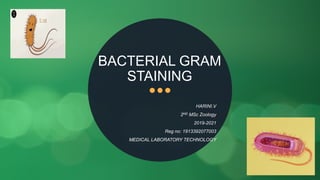Bacterial gram staining
•Download as PPTX, PDF•
0 likes•82 views
It is a method of differentiating bacterial species into two large groups (Gram-positive and Gram-negative bacteria.
Report
Share
Report
Share

Recommended
More Related Content
What's hot
What's hot (19)
Difference between Gram Positive and Gram Negative Bacteria

Difference between Gram Positive and Gram Negative Bacteria
Medical Microbiology Laboratory (bacterial shapes, arrangement and staining t...

Medical Microbiology Laboratory (bacterial shapes, arrangement and staining t...
PREPARATION OF BIOLOGICAL SPECIMENS FOR LIGHT MICROSCOPY 

PREPARATION OF BIOLOGICAL SPECIMENS FOR LIGHT MICROSCOPY
Identification of normal bacteriological flora of skin,

Identification of normal bacteriological flora of skin,
Similar to Bacterial gram staining
Similar to Bacterial gram staining (20)
Gram staining Principle, Procedure, Reagents required for Gram Staining and t...

Gram staining Principle, Procedure, Reagents required for Gram Staining and t...
gram positive and gram negative bacteria- lec 2.pptx

gram positive and gram negative bacteria- lec 2.pptx
403149684 stainingtechniquesgp-150203151421-conversion-gate02-pdf

403149684 stainingtechniquesgp-150203151421-conversion-gate02-pdf
More from HariniV39
More from HariniV39 (7)
Recently uploaded
Recently uploaded (20)
Asymmetry in the atmosphere of the ultra-hot Jupiter WASP-76 b

Asymmetry in the atmosphere of the ultra-hot Jupiter WASP-76 b
Forensic Biology & Its biological significance.pdf

Forensic Biology & Its biological significance.pdf
Labelling Requirements and Label Claims for Dietary Supplements and Recommend...

Labelling Requirements and Label Claims for Dietary Supplements and Recommend...
Creating and Analyzing Definitive Screening Designs

Creating and Analyzing Definitive Screening Designs
Recombinant DNA technology (Immunological screening)

Recombinant DNA technology (Immunological screening)
PossibleEoarcheanRecordsoftheGeomagneticFieldPreservedintheIsuaSupracrustalBe...

PossibleEoarcheanRecordsoftheGeomagneticFieldPreservedintheIsuaSupracrustalBe...
All-domain Anomaly Resolution Office U.S. Department of Defense (U) Case: “Eg...

All-domain Anomaly Resolution Office U.S. Department of Defense (U) Case: “Eg...
Biogenic Sulfur Gases as Biosignatures on Temperate Sub-Neptune Waterworlds

Biogenic Sulfur Gases as Biosignatures on Temperate Sub-Neptune Waterworlds
Botany krishna series 2nd semester Only Mcq type questions

Botany krishna series 2nd semester Only Mcq type questions
High Class Escorts in Hyderabad ₹7.5k Pick Up & Drop With Cash Payment 969456...

High Class Escorts in Hyderabad ₹7.5k Pick Up & Drop With Cash Payment 969456...
Seismic Method Estimate velocity from seismic data.pptx

Seismic Method Estimate velocity from seismic data.pptx
SAMASTIPUR CALL GIRL 7857803690 LOW PRICE ESCORT SERVICE

SAMASTIPUR CALL GIRL 7857803690 LOW PRICE ESCORT SERVICE
Chemical Tests; flame test, positive and negative ions test Edexcel Internati...

Chemical Tests; flame test, positive and negative ions test Edexcel Internati...
Bacterial gram staining
- 1. BACTERIAL GRAM STAINING HARINI.V 2ND MSc Zoology 2019-2021 Reg no: 1913392077003 MEDICAL LABORATORY TECHNOLOGY
- 2. INTRODUCTION GRAM STAINING is a method of differentiating bacterial species into 2 large groups ( GRAM-POSITIVE & GRAM- NEGATIVE) It was developed by CHRISTIAN GRAM in 1884.
- 3. CONTENT PRINCIPLE REAGENTS PROCEDURE WORKS EXAMPLES SUMMARY
- 4. DIFFERENTIAL STAINING Differential staining is a staining process which uses more than one chemical stain. It distinguishes organisms based on their interactions with multiple stains.
- 5. PRINCIPLE GRAM POSITIVE- When the bacteria is stained with primary stain crystal violet and fixed by the mordant, some of the bacteria are able to retain the primary stain and some are decolorized by alcohol. The cell walls of gram positive bacteria have a thick layer of protein-sugar complexes called peptidoglycan and lipid content is low. Decolorizing the cell causes the thick cell wall to dehydrate and shrink, which closes the pores in the cellwall and prevents the stain from exiting the cell. So the ethanol cannot remove the Crystal Violet-Iodine complex that is bound to the thick layer of peptidoglycan of gram positive bacteria and appears blue or purple in colour. GRAM NEGATIVE- cell wall also takes up the CV-Iodine complex but due to the thin layer of peptidoglycan and thick outer layer which is formed of lipids, CV-Iodine complex gets washed off. When they are exposed to alcohol, decolorizer dissolves the lipids in the cell walls, which allows the crystal violet-iodine complex to leach out of the cells. Then when again stained with safranin, they take the stain and appears red in color.
- 7. REAGENTS •Crystal Violet, the primary stain •Iodine, the mordant •A decolorizer made of acetone and alcohol (95%) •Safranin, the counterstain
- 8. PROCEDURE Take a clean, grease free slide and prepare a bacterial smear.
- 9. PROCEDURE Air dry and heat fix
- 10. . Crystal Violet was poured and kept for about 30 seconds to 1 minutes and rinse with water.
- 11. Flood the gram’s iodine for 1 minute and wash with water.
- 12. Then ,wash with 95% alcohol or acetone for about 10-20 seconds and rinse with water.
- 13. Add safranin for about 1 minute and wash with water.
- 14. Air dry, Blot dry and Observe under Microscope.
- 16. GRAM STAINING WORKS 1.The primary stain (crystal violet) binds to peptidoglycan, coloring cells purple. Both gram- positive and gram-negative cells have peptidoglycan in their cell walls, so initially, all bacteria stain violet. 2.Gram's iodine (iodine and potassium iodide) is applied as a mordant or fixative. Gram- positive cells form a crystal violet-iodine complex. 3.Alcohol or acetone is used to decolorize the cells. Gram-negative bacteria have much less peptidoglycan in their cell walls, so this step essentially renders them colorless, while only some of the color is removed from gram-positive cells, which have more peptidoglycan (60- 90% of the cell wall). The thick cell wall of gram-positive cells is dehydrated by the decolorizing step, causing them to shrink and trapping the stain-iodine complex inside. 4.After the decolorizing step, a counterstain is applied (usually safranin, but sometimes fuchsine) to color the bacteria pink. Both gram-positive and gram-negative bacteria pick up the pink stain, but it is not visible over the darker purple of the gram-positive bacteria. If the staining procedure is performed correctly, gram-positive bacteria will be purple, while gram-negative bacteria will be pink.
- 17. EXAMPLES Gram Positive Bacteria: Actinomyces, Bacillus, Clostridium, Corynebacterium, Enterococcus, Gardnerella, Lactobacillus, Listeria, Mycoplasma, Nocardia, Staphylococcus, Streptococcus, Streptomyces ,etc. Gram Negative Bacteria: Escherichia coli (E. coli), Salmonella, Shigella, and other Enterobacteriaceae, Pseudomonas,Moraxella, Helicobacter, Stenotrophomonas, Bdello vibrio, acetic acid bacteria, Legionella etc.
- 19. THANK YOU